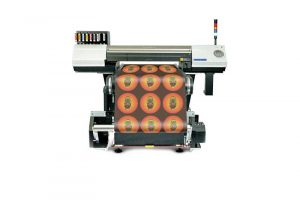
New, hybrid ultraviolet (UV) printers allow users to print on flexible media as well as thicker printable substrates.
Evolving flexibility of DTG production
What trends have you seen in the textile/direct-to-garment (DTG) market?
Kitt Jones (KJ): With the rapid rise of e-commerce, we have seen an explosion in demand for custom-printed apparel. As a result, the market’s supply of custom printed T-shirts has grown, leaving shops fighting with a plethora of competitors over pennies of profit—and there is only so much you can charge for a shirt.
Manufacturers have responded with innovative large-format DTG printers, which offer users the flexibility to print on a wide variety of apparel and textile products. Today, we are seeing many shops looking to move “beyond the T-shirt,” diversifying their product lines to offer less common and higher-margin items like personalized towels, jackets, and jeans.
What do some of the newer DTG printers provide in terms of features?
KJ: The newest DTG printers offer users improved speeds, higher-quality print, and lower production costs. Beyond overall enhancements like these, it is important to consider the additional capabilities of newer large-format DTG printers. Production capacity is another key feature when considering printing technology. A high-production DTG printer can print as much as three standard DTG printers, while only requiring one operator.
How is today’s software making DTG more accessible?
KJ: Software is a key element in DTG, and it is really where the momentum is right now. Raster image processor (RIP) software is processing data faster, adding automation, and controlling inks better, which allows different types of printing by managing the white under base more effectively. In addition, user interfaces are being simplified to automate workflows, to make operating small- and large-format DTG printers easier than ever.
What new directions do you see for the DTG market heading into 2023?
KJ: I think the roadmap for growth in DTG is positive. I see the market moving towards personalization and customization of a wider variety of fabric and apparel products. Certain machines allow users to print on larger and smaller products—everything from T-shirts to sleeping bags. A Z axis clearance of up to 203.2 mm (8 in.) allows users print on diverse products such as decor and accessories, as well as apparel.
Analyzing Canada’s digital print market
How is the Canadian market doing overall?
Don Ross (DR): As we move beyond the pandemic shutdown, the Canadian market is slowly rebounding. It has not yet recovered its previous momentum, due in part to the current exchange rate with the U.S. dollar. Further, conferences and other events are returning at a cautious pace.
Are supply chain delays continuing to impact the digital printing market?
DR: Pandemic-related supply chain issues have certainly hurt print providers, and vendors who have been less impacted by the supply chain have benefited. Fortunately, we are seeing a gradual easing of these supply chain issues.

The ability to print on items like tote bags, towels, and napkins gives PSPs new options for customizing products.
Which types of digital printing devices are seeing growth in Canada?
DR: Of the various types of digital print devices, the Canadian market for UV print devices has shown continued growth, and I expect this growth will continue into 2023.
Moving forward
Overall, the market for digital print continues to expand. However, market factors such as exchange rates and supply chain concerns may hinder the ability for PSPs to respond quickly. Advances in print technology, inks, and software mean today’s digital print devices can print on an even wider range of products and substrates, meeting the market’s demands for rapidly produced and customized products, while remaining easy to operate and maintain.
Notes
1 For more information, visit https://www.marketsandmarkets.com/Market-Reports/digital-printing-market-97124440.html.
Ginny Mumm is a freelance consultant for digital inkjet printer/cutter provider Roland DGA. For more information, visit www.rolanddga.com.





